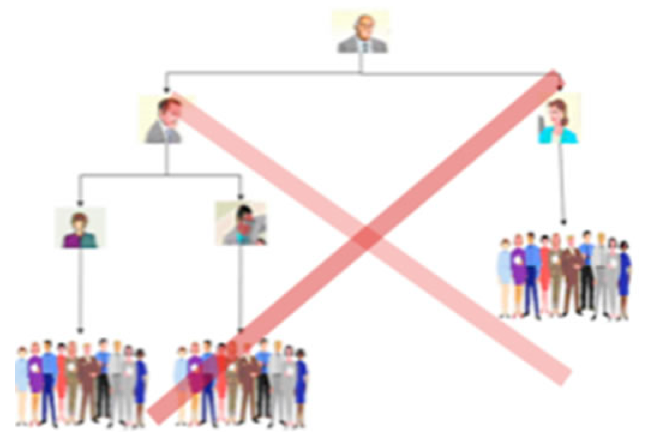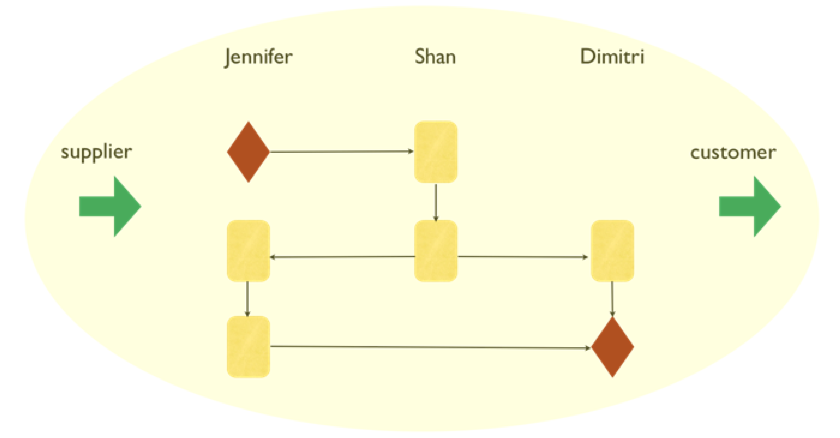 In this post we look at how we can create a sustainable system, how we can operate as a sustainable system, and the results this will help us achieve.
In this post we look at how we can create a sustainable system, how we can operate as a sustainable system, and the results this will help us achieve.
What would happen if everyone came to work and just did their own thing? Even with the best of intentions, this would not be a great way to get results. That’s why we work in “organizations”, as small or large as they may be. We bring our own competencies, we work together towards a goal, but individual efforts can only lead to achieving that goal when they are combined in an orderly way.
We can achieve this with the best results by understanding and managing our organizations as a system. Any enterprise or organization is a system. This is a fact, whether we are aware of it or not. This means that our organization/system is a network of interdependent components that work together to achieve the goal of the system. This may not sound very attractive, as if we were bits of an electrical circuit. But think of how organizations are traditionally depicted, those dehumanizing rows of isolated horizontal and vertical boxes. By its very nature, a hierarchy, no matter how small or large, encourages ‘getting ahead’ and the hedging of territory and information, as opposed to collaboration. Organizations are not matrices. They are, instead, made up of humans who interact, who have conversations, who interdepend. Human activity is not about boxes, but about flow. 
What happens when we ignore the organic structure of our organization? We think small, we fall back into traditional roles and departments, we think that certain matters our not our concern but somebody else’s, we miss out on valuable exchanges of information, and we optimize things on the basis of our own, or our department’s, benefit instead of that of the organization. We fail to see how all our activities are interconnected and interdependent. In other words, we under-optimize our efforts, and our output.
Creating a sustainable system
How can we more accurately depict, organize, and measure this flow that is our organization? At its most basic level, if you can imagine an x-ray of a company, it could be seen as a set of recurring and non-recurring activities. For instance, ordinary maintenance, book keeping and closing, production scheduling, shipping, etc. are recurring activities; the introduction of a new technology, the expansion of premises, the launch of a new product, can be seen, in a way, as non-recurring activities. These activities are not carried out by isolated individuals or isolated ‘functions’. They inevitably cross over the artificial boundaries created by a more traditional view of an organization. These activities, and the people who carry them out, interconnect and interdepend. And these interdependencies do not stay the same, they evolve over time.
Once we come to understand that our company is in fact a system, then we must understand how to build correctly the interdependencies that make up our particular set of activities/processes so they achieve our goal. This will allow us to build a robust and sustainable system, whether our organization is big or small, whether we deliver goods or services. This will provide us with an organizational structure that can foster cooperative work. So, to recap, we know that the hierarchical/functional idea of an organization is inadequate as it creates artificial barriers and does not allow a true understanding of the organization as a series of recurring and non-recurring activities. What we need is an organizational structure that facilitates the orderly management of sets of activities that are continuously created, coordinated, cross-functional, and that evolve in time. There is a precise name for this in English: projects.
Operating as a sustainable system
A project is exactly this: a network of interdependencies created to achieve a precise goal in a well-defined time frame. A project is a system with a precise duration. A company viewed as a system is therefore a network of projects, and the orderly creation and timely completion of these projects should accomplish the stated goal of the network. On a practical level, how do we organize and manage this network? By building a map. We are able to create an accurate map of this network of projects by using Deployment Flowcharts to map out every process within the company, identifying who does what and when.  Functional roles disappear. Instead, the map of our organization, or Playbook, as we like to call it, details the network of conversations that must occur (daily, weekly, monthly, etc.) in our system in order to make our linkages effective. The playbook is the nervous system of the organization; it captures all the connections that make the working of the company possible. It is the living, ever-evolving document that portrays the life of the organization. It does so at different levels by:
Functional roles disappear. Instead, the map of our organization, or Playbook, as we like to call it, details the network of conversations that must occur (daily, weekly, monthly, etc.) in our system in order to make our linkages effective. The playbook is the nervous system of the organization; it captures all the connections that make the working of the company possible. It is the living, ever-evolving document that portrays the life of the organization. It does so at different levels by:
- depicting how all the processes are linked
- describing how these processes must be performed
- specifying which activities these processes entail and who is supposed to perform them
- illustrating the inputs and outputs of these activities
- recording the expected outcome of these activities; designing, validating and testing all the improvement activities
and, most importantly, by gaining statistical insight into the life of our organization.
Results of operating a sustainable system
When we have correctly built the interdependencies of our system and mapped them as a playbook, we can expect the organization to:
- increase focus of efforts towards the goal
- understand and eliminate any negative loops or redundancies in our processes
- increase the speed and quality in delivering the goal
- achieve an inbuilt continuous improvement mechanism through feedback cycle
In our next article we will be looking at the impact of variation on the processes that make up our organization, and how a straightforward statistical tool can help us measure, predict and improve all the activities we perform to achieve our goal.
Sign up to our blog here and shift your thinking towards broader, systemic possibilities for yourself and your organization. Intelligent Management provides education and training on systemic management, W. Edwards Deming’s management philosophy and the Theory of Constraints (Decalogue methodology) in North America and Europe.
About the Author
Angela Montgomery Ph.D. is Partner and Co-founder of Intelligent Management and author of the business novel+ website The Human Constraint that has sold in over 20 countries. She is co-author with Dr. Domenico Lepore, founder, and Dr. Giovanni Siepe of ‘Quality, Involvement, Flow: The Systemic Organization’ from CRC Press, New York.





Leave a Reply